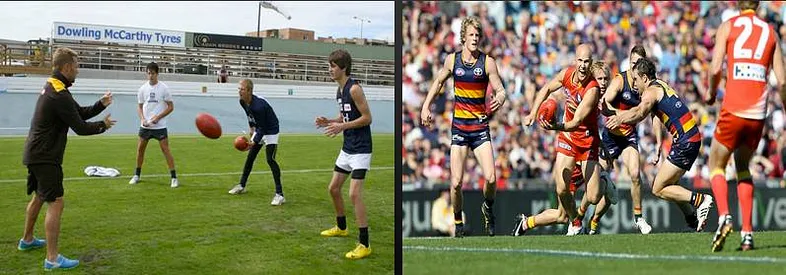This is a short post based on recent observations of some practice activities/sessions being shared online.
I’m seeing a few recurring examples (usually of the “isolated technique” or “breakdown” drill variety - more on the issues with that here) where progressions of an activity are based on doing a skill(s) quicker, more accurately and/or executing greater number of repetitions without an error. The philosophy seems to be based on the idea that by doing this players are being “stretched” and improving performance.
The reality is players are getting better at performing in THAT activity. If this activity bears little resemblance to the situations in a match where the skill may be used, then performance in those MATCH situations is not being enhanced. The images below represent this dynamic - improvement in static handpassing from 50 reps to 100 reps without a mistake (picture on the left) is unlikely to contribute much to improved performance in the context of handpassing in match situations (picture on the right).

Remember the purpose for creating a simplified activity to begin with is so players can experience a certain level of success (& exposure to mistakes) in order to facilitate learning.
Once they reach a relative level of success, we should then be stretching or challenging players by increasing the complexity of the activity. So if we are doing an unopposed 4-point square passing activity, once players can frequently pass to a teammate accurately (say 60–70% of the time), the objective is NOT to get to 100% or do it quicker (often perfection is unattainable and not required). From my own experiences, I know it is easy to get caught up in trying to master or perfect performance in a drill and forget about the “bigger picture” of how it relates to the match.
Instead, exceeding a certain threshold of “success” should be the cue to increase the complexity of the activity, such as…
- adding a defender(s) (hopefully at least 1 is already present in your activity)
- creating more variability in types of passes and ways ball is received/controlled (on the move, movement not restricted by cones)
- incorporating other skills interspersed with the passing (random practice)
With increasing complexity the activity generally increases it’s resemblance (“representativeness”) to game situations, even to the point where the activity may become more difficult than situations faced in a match, ie extremely limited time and space. By doing this we are increasing the probability of performance gains in the activity transferring into the “real match”.
When the long-term objective is quality performance at the elite level of a team sport, players need to develop the ability to perform effectively & efficiently, but not necessarily perfectly, in highly complex & dynamic situations. Creating appropriate progressions in complexity of practice activities is critical, and a key skill for a coach to possess.
Do you have this skill?
image credit Keith Allison from Hanover, MD, USA, CC BY-SA 2.0, via Wikimedia Commons
